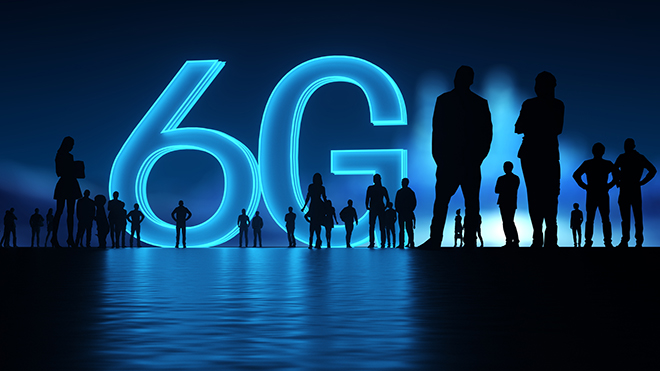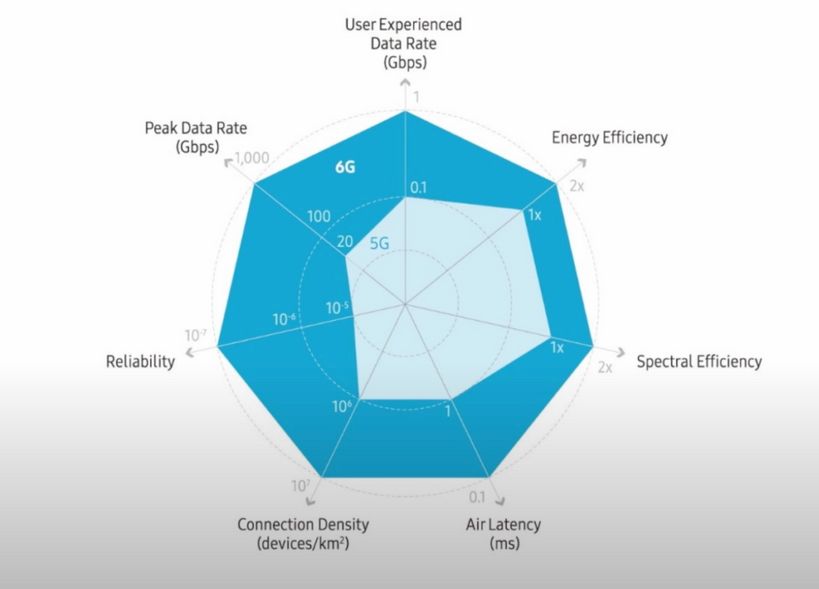blog / 6G and the Need for Speed
6G and the Need for Speed

Utkarsh Venaik
B.Tech.

We have seen continuous improvements in network speeds throughout the past few decades, but what tradeoffs do we make to achieve them? This is what we aim to discuss through this blog.
You might have heard about 2G, 3G, 4G and possibly 5G as well. The cool part about all these networks has been that each one has been exponentially more powerful than its predecessor.
The first-ever mobile phones were called 0G phones, the old gen, boxy landline phones which had no mobility whatsoever, then came 1G the phones supporting 1G were basically wireless landline phones which some of us may have seen in our childhood, then came in 2G, which was around 15x faster than 1G. These phones could not only call but also send images and text messages. After this, there was no looking back; the next-gen, 3G, brought up a breathtaking leap of 50x over its predecessor, which was groundbreaking at the time.

3G brought with it a new era in the tech industry providing support to web-based applications such as UBER, Facebook, and Instagram. When 3G came out, the hype was such that even apple named one of its devices to take benefit of the hype, the 'Apple iPhone 3G'.
The next in line, 4G was at its best, 500x faster than 3G, which brought a new era of possibilities and innovations. Things such as online RPG games such as PUBG with 100s of players playing together simultaneously became possible with 4G. Videos could now be streamed in higher quality, such as 1080p, practical use of IoT was given birth, and the tech world was advanced as ever!
After 4G, 5G has recently been everywhere in the news; at the moment, very few Indians have access to 5G networks; however, about 1.17 billion people worldwide already have access to 5G, and the numbers are estimated to double up by the end of this year.
In this blog, we take another step ahead and discuss about the next gen of speed and productivity: 6G
It may sound a bit over the top since many people may just have recently heard about 5G itself. Still, it's important to note that newer and faster tech is proportional to higher sales for companies such as smartphone manufacturers. These companies usually strive to find potential generational technological leaps in their gadgets earlier than their competition to be the trailblazers of the community. It’s intriguing to know that Samsung had already built a working 5G network back in 2013 itself, much before the majority of people even heard about its existence, so even though 6G may be scheduled for 2030 for the larger masses, many companies are already working on it today!
What is even more fun to know is that a primitive 6G chip has already been built successfully by one of the tech companies. Moreover, Samsung has already published an official article stating in what aspects is 6G expected to surpass 5G.

On a closer look, we notice that apart from the hype that 6G brings with it, it is theoretically supposed to be only about 50x faster than the 5G networks with lesser latency.
We may argue about the need for a 6G network since our life is already working smoothly with 4G, and many people may even think twice before switching to 5G at this point, so what exactly is the point of having 6G?
We must understand that 6G is expected to come out in the 2030s and is supposed to carry the generations till 2040, which obviously will come up with inventions of its own such as self- driven cars being more profound till then, forward sprints in AI, automation and some progress in futuristic fields such as Internet of Everything(IoE) is also expected by then. Innovations such as self-driven cars require precise timings, and the lesser the latency, the better it will be. There is no limit as to how fast tech should really be. With higher speeds available, the world will soon become accustomed to the new normal.
So, is there any catch here? Is there an underlying problem with 6G?

You may have noticed from personal experiences that 3G was a bit more consistent than 4G; 4G networks are somewhat more patchy in use which is because the 4G waves are only capable of travelling about 1000 feet, so if we are further away than about 1000 ft from a 4G tower we are out of network and the farther we are, the slower will be the speed. This problem was only topped up with the arrival of 5G networks; the key to delivering more speed is to increase the frequency of the waves, which means lesser wavelength and lesser range of the network waves, which in turn makes them more easily blockable by obstacles such as buildings or trees which is undesirable since we will have to use our devices in open areas to avoid 5G signals to vanish away in between of use indoors. To tackle this, we need to increase the frequency of towers. To give you a perspective. In contrast, we needed one big 4G tower to support an entire city; we will now need a 5G tower in every street to deliver the expected 5G speed. The wavelength of these 5G waves is so small that they are called millimetre waves which are argued by many experts that these millimetre waves cannot be delivered in the rural parts and relatively farther places from the mainland of the country at all. To avoid this problem of “all or nothing” of these short-ranged 5G waves, a sub 5G wave which can also be understood as a wave which is somewhere between 4G and 5G, needs to be provided to ensure some sort of service to these 5G smartphones at all times. Besides all this, the chipset must be capable of switching between the different networks 4G, 3G and 2G seamlessly since they are even needed at all times.
6G waves are called sub-millimetre waves and are one-tenth of the size of the already short 5G waves. When we cannot even cover areas beyond major cities with 5G, how do we connect the entire globe with an even shorter wave? Doesn’t it seem way too farfetched? To provide uninterrupted and fast 5G networks, we will have to cover the whole place with more and more towers Now, coming to 6G, this problem may become even more severe, and we may have to cover the entire skylines with network towers to achieve our goals. To add up to this problem, 6G networks are even more prone to be blocked by obstacles due to their shorter wavelength than 5G. Hence, it may be the case that each office/ household may need to have multiple transmitters embedded into the furniture and have 6G antennas built-in into the architecture of the buildings to support the 6G dream.
But even if we succeed in doing all of this, there is still a problem. As we saw earlier through the graph, 6G is not just supposed to be faster than its predecessor but it also needs to provide all the other benefits that are supposed to come with a “new gen” tech. Hence, a few companies proposed unconventional to approaches for the sake of practicality of “6G” in order to avoid the problems that come with sub-millimetre waves, one of them is the use of AI to achieve more effective forms of communication between intelligent devices, which reduces dependency network speeds for its functioning. The companies also pointed out a possible need for new antenna technology which is not availiable yet but may be needed in the future to make the 6G dream come true sustainably
Another approach which may be possible is to rethink the whole tower antenna system; instead of having one tower transmitting signals to all devices around it, we may have to make every device a transmitter embedded receiver in itself, which means that each device which is capable of receiving 6G will also be able to transmit 6G signals around it which helps in increasing the network range by creating a web of networks which again brings up another critical aspect to the picture which is the security of the users since this web structure may open up a wide scope of possible cyber security threats and data breaches.
Among all of this, there are environmental repercussions of 6G too. Each new generation of a network also tends to see an increase in power consumption with increasing awareness in the common population about the environment it is highly unlikely that companies would be able to blindly use as much energy as they want to achieve their targets, hence environmental aspects has lead to yet another constraint for 6G.
It seems unlikely that the current frequency of upgrades will be kept up in the future. We seem to be approaching a saturation point in terms of network speeds with the currently available technology; however, with the ever-increasing 'Need-for-speed' of humans, it will be really interesting to see what next the tech giants are going to come up!
REFERENCES:
- IEEE webinar on 'how 6G promises to build a sustainable future' by Mr Onel L A Lopez, 6G Flagship
- Slides uploaded by 6G flagship 'how 6G promises to build a sustainaible future'
- Youtube video by the channel 'seeker'
- Youtube video titled '6G explained' by Mrwhosetheboss
6g tech